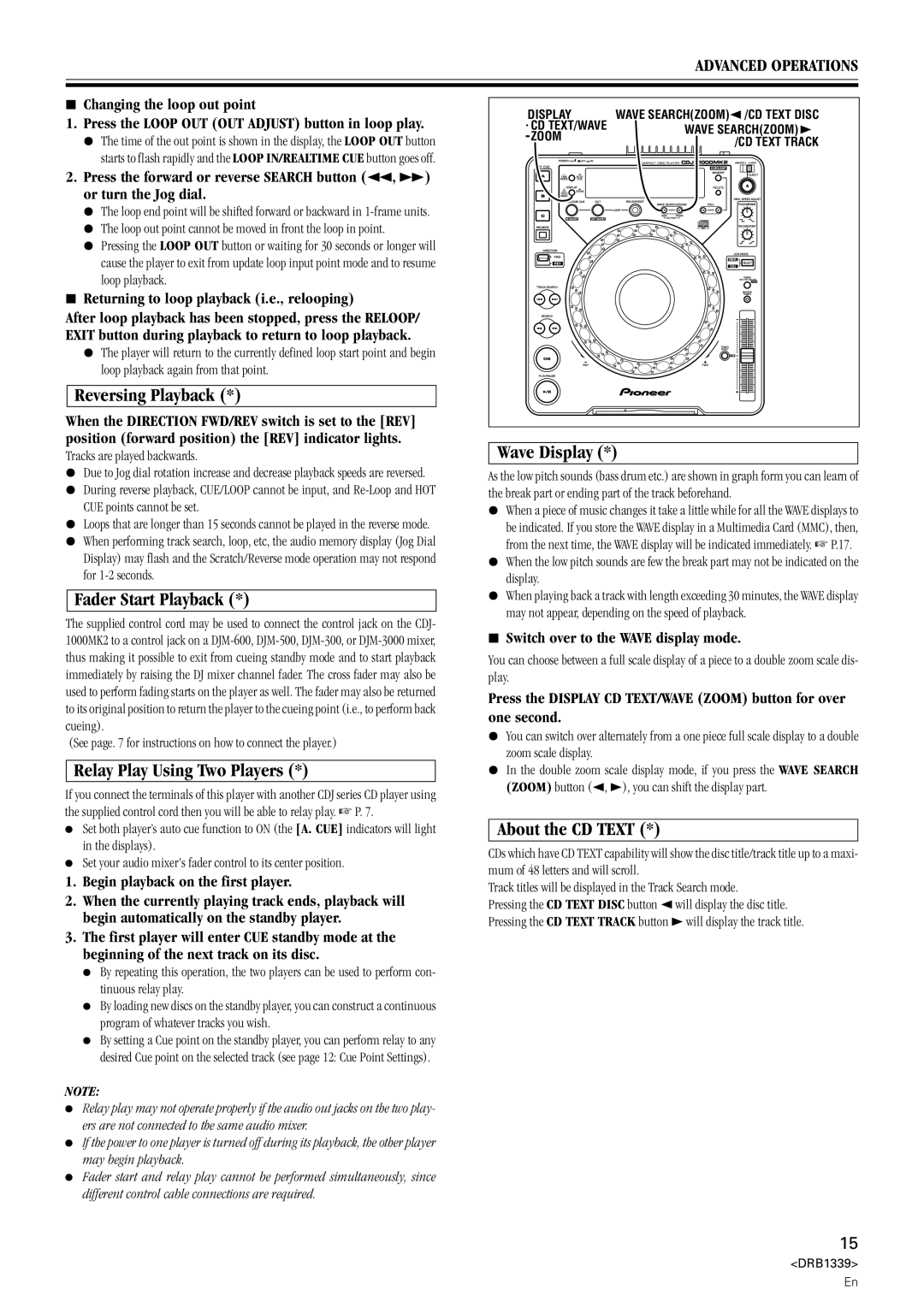
ADVANCED OPERATIONS
7Changing the loop out point
1.Press the LOOP OUT (OUT ADJUST) button in loop play.
¶The time of the out point is shown in the display, the LOOP OUT button starts to flash rapidly and the LOOP IN/REALTIME CUE button goes off.
2.Press the forward or reverse SEARCH button (1, ¡) or turn the Jog dial.
¶The loop end point will be shifted forward or backward in
¶The loop out point cannot be moved in front the loop in point.
¶Pressing the LOOP OUT button or waiting for 30 seconds or longer will cause the player to exit from update loop input point mode and to resume loop playback.
7Returning to loop playback (i.e., relooping)
After loop playback has been stopped, press the RELOOP/ EXIT button during playback to return to loop playback.
¶The player will return to the currently defined loop start point and begin loop playback again from that point.
Reversing Playback (*)
When the DIRECTION FWD/REV switch is set to the [REV] position (forward position) the [REV] indicator lights.
Tracks are played backwards.
¶Due to Jog dial rotation increase and decrease playback speeds are reversed.
¶During reverse playback, CUE/LOOP cannot be input, and
¶Loops that are longer than 15 seconds cannot be played in the reverse mode.
¶When performing track search, loop, etc, the audio memory display (Jog Dial Display) may flash and the Scratch/Reverse mode operation may not respond for
Fader Start Playback (*)
The supplied control cord may be used to connect the control jack on the CDJ- 1000MK2 to a control jack on a
(See page. 7 for instructions on how to connect the player.)
Relay Play Using Two Players (*)
If you connect the terminals of this player with another CDJ series CD player using the supplied control cord then you will be able to relay play. ☞ P. 7.
÷Set both player’s auto cue function to ON (the [A. CUE] indicators will light in the displays).
÷Set your audio mixer's fader control to its center position.
1.Begin playback on the first player.
2.When the currently playing track ends, playback will begin automatically on the standby player.
3.The first player will enter CUE standby mode at the beginning of the next track on its disc.
÷By repeating this operation, the two players can be used to perform con- tinuous relay play.
÷By loading new discs on the standby player, you can construct a continuous program of whatever tracks you wish.
÷By setting a Cue point on the standby player, you can perform relay to any desired Cue point on the selected track (see page 12: Cue Point Settings).
NOTE:
÷Relay play may not operate properly if the audio out jacks on the two play- ers are not connected to the same audio mixer.
÷If the power to one player is turned off during its playback, the other player may begin playback.
÷Fader start and relay play cannot be performed simultaneously, since different control cable connections are required.
DISPLAY | WAVE SEARCH(ZOOM)2/CD TEXT DISC | |
CD TEXT/WAVE | WAVE SEARCH(ZOOM) 3 | |
ZOOM | ||
/CD TEXT TRACK | ||
|
Wave Display (*)
As the low pitch sounds (bass drum etc.) are shown in graph form you can learn of the break part or ending part of the track beforehand.
¶When a piece of music changes it take a little while for all the WAVE displays to be indicated. If you store the WAVE display in a Multimedia Card (MMC), then, from the next time, the WAVE display will be indicated immediately. ☞ P.17.
¶When the low pitch sounds are few the break part may not be indicated on the display.
¶When playing back a track with length exceeding 30 minutes, the WAVE display may not appear, depending on the speed of playback.
7Switch over to the WAVE display mode.
You can choose between a full scale display of a piece to a double zoom scale dis- play.
Press the DISPLAY CD TEXT/WAVE (ZOOM) button for over one second.
¶You can switch over alternately from a one piece full scale display to a double zoom scale display.
¶In the double zoom scale display mode, if you press the WAVE SEARCH (ZOOM) button (2, 3), you can shift the display part.
About the CD TEXT (*)
CDs which have CD TEXT capability will show the disc title/track title up to a maxi- mum of 48 letters and will scroll.
Track titles will be displayed in the Track Search mode.
Pressing the CD TEXT DISC button 2will display the disc title. Pressing the CD TEXT TRACK button 3will display the track title.
15
<DRB1339>
En
